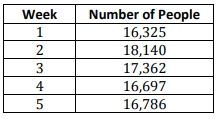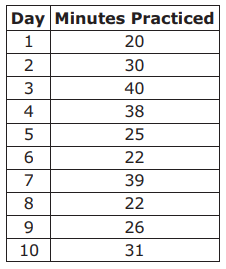General Information
Clusters should not be sorted from Major to Supporting and then taught in that order. To do so would strip the coherence of the mathematical ideas and miss the opportunity to enhance the major work of the grade with the supporting clusters.
Test Item Specifications
- Mean: 17,123
- Mean absolute deviation: 611
- Activity A: Watch the Whales - Determine average speed, distance, and percentage of time at the surface of gray whales.
- Activity B: Time Tally - From observations of a dolphin determine total time and percentage of time of certain behaviors.
- Activity C: Deep Divers - Determine average dive depth, diving time, and surface time of an elephant seal.
- Activity D: Breaches of the Humpback - Graph data and make a prediction from the graph. In this activity, the students will practice problem solving skills to solve complex real-life problems.
Data sets in items must be numerical data sets.
No
Allowable
Sample Test Items (3)
| Test Item # | Question | Difficulty | Type |
| Sample Item 1 | Tim drives the Grand Avenue bus route. The total number of people who ride the bus
each week for 5 weeks is shown in the data table.
How many more people need to ride the bus in week 6 to increase the mean number of riders per week by 10? |
N/A | EE: Equation Editor |
| Sample Item 2 | Linda recorded the number of minutes she practiced playing her violin for
10 days. The table shown represents the data she collected.
A. According to the data, what is the average amount of time Linda spent practicing per day? B. What is Linda’s variation among all 10 days? |
N/A | EE: Equation Editor |
| Sample Item 3 | Tim drives the Grand Avenue bus route. He records the total number of
passengers each week for 4 weeks.
The mean and mean absolute deviation of the data are shown.
|
N/A | MS: Multiselect |
Related Courses
Related Resources
Formative Assessments
| Name | Description |
| Explain Measures of Variability | Students are asked to list measures of variability and explain what they indicate about a set of data. |
| Explain Measures of Center | Students are asked to list measures of center and explain what they indicate about a set of data. |
| Compare Measures of Center and Variability | Students are asked to explain the difference between measures of center and measures of variability. |
Lesson Plans
| Name | Description |
| Analyze Data | This lesson uses statistical analysis to evaluate data. The data used is from the app created by the students in lesson 2 of the Data Set and Statistics Unit. This lesson also guides students in recognizing the different types of data collected and how the distribution's shape can be affected when graphed at different intervals in histograms. This is the final lesson in the unit. |
| Sea Ice Analysis Grade 6 | The changing climate is an important topic for both scientific analysis and worldly knowledge. This lesson uses data collected by the National Snow and Ice Data Center to create and use statistical analysis as a tool to evaluate the mean and variation from the mean of sea ice loss. |
| Sensoring Data | In this follow up lesson, students will explore data collection using the weather station sensor and perform statistical analysis of the data. Students will use a scientific method of inquiry to plan an investigation of their own. This activity is meant to allow students to use a variety of skills they have acquired throughout a statistics unit in a personally meaningful way. |
| Measurement Data Error | In this interdisciplinary lesson, students will practice the skill of data collection with a variety of tools and by statistically analyzing the class data sets will begin to understand that error is inherent in all data. |
| Sensoring Data | In this follow up lesson, students will explore data collection using the weather station sensor and perform statistical analysis of the data. Students will use a scientific method of inquiry to plan an investigation of their own. This activity is meant to allow students to use a variety of skills they have acquired throughout a statistics unit in a personally meaningful way. |
| Data Detectives | In this lesson, students will become "Data Detectives" as they investigate that a measure for the center of a numerical data set summarizes all of its values with a single number, while a measure of variation describes how its values vary with a single number. The students will utilize cooperative learning structures, hands-on learning activities and the Standards for Mathematical Practices as they delve into the world of understanding the concept of "mean" and numerical data sets. |
| Universal GPA | This lesson incorporates examples that are relevant to students' interests and uses diverse methods of presentation to demonstrate how changes in measures of variation can affect the measure of central tendency. The lesson utilizes the concept of grade point average (GPA) to create a real world example that student can relate to and apply. The lesson also includes a manipulative lab to demonstrate the idea of distribution of data as it relates to changing the value of a data point(s). |
| Backpack Weight | Just how heavy is your backpack? In this lesson students find measures of center in fun and meaningful ways. They will review mean, median, range and outlier, become a number set, and work together gathering and representing data about the weight of their backpacks. |
| Calculating the Mean, Median, Mode, and Range from a Frequency Chart | This lesson lasts a total of two hours: 15-minute pre-lesson, 90-minute lesson, and 15-minute follow up lesson or homework. Students will need the two worksheets, a mini-whiteboard, a pen, and an eraser. Each small group will need both card sets, a large sheet of paper, and a glue stick. Students will generate responses to a question about favorite computer games and use this data for the lesson. Students will then work collaboratively to display different data and discuss various strategy approaches. |
| Flipping the house | The Gonzalez family is moving to Florida and they need our students' help deciding which neighborhood to live in. To help them, the students will calculate the mean and median of home prices in the neighborhood and trends in price changes. Model Eliciting Activities, MEAs, are open-ended, interdisciplinary problem-solving activities that are meant to reveal students’ thinking about the concepts embedded in realistic situations. MEAs resemble engineering problems and encourage students to create solutions in the form of mathematical and scientific models. Students work in teams to apply their knowledge of science and mathematics to solve an open-ended problem while considering constraints and tradeoffs. Students integrate their ELA skills into MEAs as they are asked to clearly document their thought processes. MEAs follow a problem-based, student-centered approach to learning, where students are encouraged to grapple with the problem while the teacher acts as a facilitator. To learn more about MEAs visit: https://www.cpalms.org/cpalms/mea.aspx |
| Play Like you "MEAN" It! - Understanding a Measure of Center | In this lesson, students will investigate how a measure of center, the mean, summarizes a numerical data set of all the values with a single number. Inquiry-based instruction along with hands-on learning is utilized to build understanding of the concept of "mean." Students will utilize Mathematical Practice Standards, as they build understanding of how the mean is used to describe a numerical data set. |
| Data Doctors | Have your students become "Data Doctors" by examining and analyzing means of central tendency. This lesson is a great introduction to mean, median, mode and range. Students will be sets of data, get to work in small groups examining the sets, view a poem that will help them remember each term, and take surveys to get real data sets. |
Original Student Tutorials
| Name | Description |
| Moving MADness | Learn how to calculate and interpret the Mean Absolute Deviation (MAD) of data sets in this travel-themed, interactive statistics tutorial. |
| It Can Be a Zoo of Data! | Discover how to calculate and interpret the mean, median, mode and range of data sets from the zoo in this interactive tutorial. |
Perspectives Video: Expert
| Name | Description |
| Mathematically Modeling Hurricanes | <p>Entrepreneur and meteorologist Mark Powell discusses the need for statistics in his mathematical modeling program to help better understand hurricanes.</p> |
Problem-Solving Task
| Name | Description |
| How Long is 30 Seconds? | The purpose of this task is for students to gain a better understanding of the passage of time. Students with the help of their teacher should work to design an investigation to find out how successful the class is at predicting when 30 seconds has passed. Once the data is recorded students should begin to graph their findings to make comparisons. |
Teaching Ideas
| Name | Description |
| A Certain Uncertainty | Students will measure the mass of one nickel 10 times on a digital scale precise to milligrams. The results will be statistically analyzed to find the error and uncertainty of the scale. |
| Stem-and-Leaf Plots | This lesson is designed to introduce students to stem-and-leaf plots as a graphical way to represent a data set. The lesson also reviews measures of central tendency with directions for finding mean, median, and mode are given. This lesson provides links to discussions and activities related to stem-and-leaf plots as well as suggested ways to integrate them into the lesson. Finally, the lesson provides links to follow-up lessons designed for use in succession with the current one. |
| Drops on a Penny (Box-and-Whiskers Graph) | Students collect data, compute measures of central tendency, and create stem-and-leaf plots and box-and-whiskers plots. |
| All Numbers Are Not Created Equal | Although a sheet of paper is much thinner than the divisions of a ruler, we can make indirect measurements of the paper's thickness. |
Tutorial
| Name | Description |
| Statistics Introduction: Mean, Median, and Mode | The focus of this video is to help you understand the core concepts of arithmetic mean, median, and mode. |
Virtual Manipulative
| Name | Description |
| Box Plotter | Users select a data set or enter their own data to generate a box plot. |
Worksheet
| Name | Description |
| Splash of Math - SeaWorld Classroom Activity | This resource allows students to assume the role of an ethologist provide 4 activities that challenge students to apply mathematics to solve complex real-life problems: |
Student Resources
Original Student Tutorials
| Name | Description |
| Moving MADness: | Learn how to calculate and interpret the Mean Absolute Deviation (MAD) of data sets in this travel-themed, interactive statistics tutorial. |
| It Can Be a Zoo of Data!: | Discover how to calculate and interpret the mean, median, mode and range of data sets from the zoo in this interactive tutorial. |
Tutorial
| Name | Description |
| Statistics Introduction: Mean, Median, and Mode: | The focus of this video is to help you understand the core concepts of arithmetic mean, median, and mode. |
Virtual Manipulative
| Name | Description |
| Box Plotter: | Users select a data set or enter their own data to generate a box plot. |


